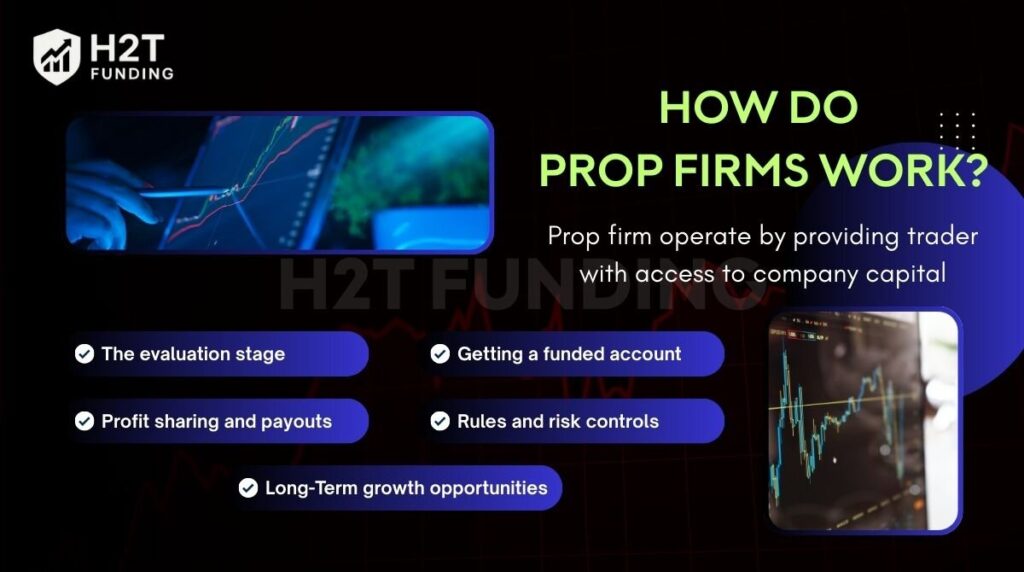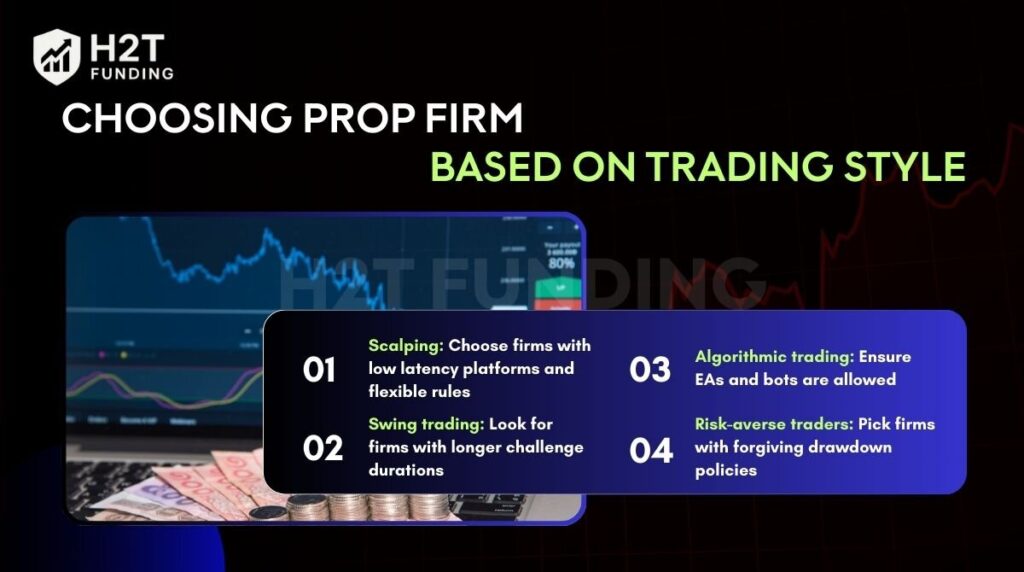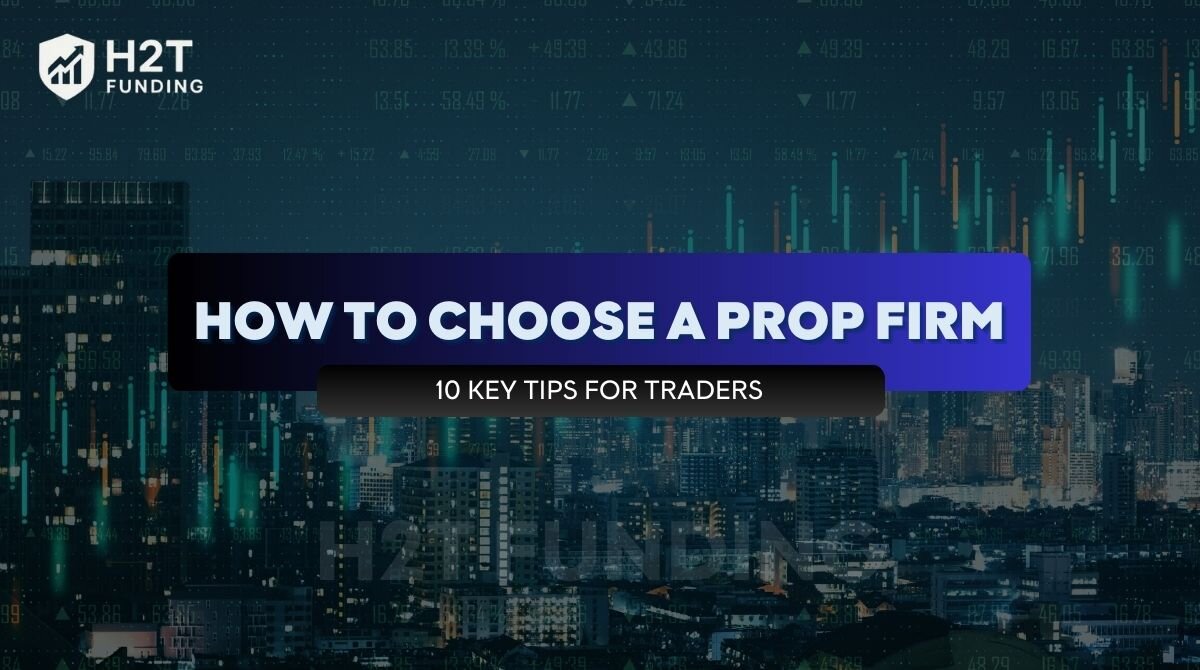How to choose a prop firm is one of the most critical decisions for any aspiring or experienced trader looking to trade with funded capital. With the explosion of prop trading firms in recent years, it’s easy to get overwhelmed by the options.
Each firm offers different rules, profit splits, platforms, and risk models, and not all are as reputable or trader-friendly as they appear. In this guide, H2T Funding will walk you through exactly how to choose the right prop firm based on your goals, strategy, and trading style using objective criteria to help you avoid costly mistakes and maximize your success.
Read the full guide to learn step-by-step how to choose a prop firm and maximize your trading success. Let’s get started!
Key takeaways
- Always check the firm’s reputation and read trader reviews to avoid scams.
- Compare profit splits, fees, and risk rules to find a firm that suits your strategy.
- Choose a firm that fits your trading style, whether scalping, swing, or algorithmic.
- Look for strong support, educational resources, and growth opportunities for long-term success.
- Understand challenge difficulty and payout rules before committing to a funded account.
1. What is a prop trading firm, and how does it operate?
A prop trading firm (short for proprietary trading firm) provides traders with access to the firm’s capital to trade financial instruments such as Forex, stocks, commodities, or crypto. Instead of risking their own money, traders use the firm’s funds and earn a portion of the profits, known as the profit split.

2. How do prop firms work?
At their core, prop firms operate by providing traders with access to company capital once they prove they can trade profitably within specific rules. The process typically begins with an evaluation phase, where the trader must reach profit targets while respecting limits such as maximum daily loss and overall drawdown.

2.1. The evaluation stage
Almost every firm starts with a test known as the evaluation or challenge. Here, traders must meet specific profit targets while following rules on losses. Two limits are especially important:
- Daily loss limit: The maximum amount a trader can lose in a single day.
- Maximum drawdown: The overall limit a trader cannot exceed, regardless of their profit level.
The evaluation may have one or two steps, depending on the firm. A single-step process is usually quicker but may have stricter requirements. A two-step process spreads the targets across two phases, giving traders more room to show consistency.
2.2. Getting a funded account
Once a trader passes the evaluation, they are awarded a funded account. This account allows them to trade with the firm’s money instead of their own. At this stage, profits are no longer simulated; real money is at stake, and earnings are shared between the trader and the firm.
2.3. Profit sharing and payouts
Most firms offer generous profit splits, often ranging from 70% to 90% in favor of the trader. The payout schedule varies, with some firms paying weekly, others bi-weekly, and some monthly. Traders must also pay attention to withdrawal rules, such as minimum profit thresholds before a payout can be requested or restrictions on the first withdrawal date after funding.
2.4. Rules and risk controls
Prop firms rely heavily on risk management to protect their capital. These rules can affect how traders approach the market. Common restrictions include:
- Not holding trades overnight or over weekends.
- Avoiding high-impact news events that create volatile market conditions.
- Limitations on using automated trading tools like expert advisors (EAs) or trading bots, unless specifically approved.
Failing to follow these rules can lead to losing the funded account, no matter how profitable the trades are.
2.5. Long-Term growth opportunities
Many firms offer scaling plans, where traders who perform well can gradually increase their funded capital. For example, consistent profitability over a set period may allow a trader’s account size to double. This structure encourages traders to focus on long-term growth rather than short-term wins.
In practice, prop firms work as a partnership: traders bring skill and discipline, while firms provide the capital and structure. This system benefits both sides. Traders get the chance to manage large sums without risking their personal savings, and firms profit by backing the best performers.
Ultimately, prop firms function through a balance of evaluations, strict risk controls, profit-sharing agreements, and opportunities for account growth. Traders who treat the process seriously, follow the rules, and stay consistent are the ones who can build lasting success with a prop firm.
3. How to choose a prop firm: 10 key criteria
Choosing the right prop firm requires more than promise; it’s about evaluating profit splits, drawdowns, trading style compatibility, and support. Checking prop firm reviews gives real trader insights to help you pick a reputable firm that fits your goals. Keep reading to explore the 10 key criteria every trader should consider when selecting a prop firm.

3.1. Reputation & transparency
A firm’s reputation is a key indicator of its reliability. Look for:
- Transparent funding process
- Transparent guidelines and assessment standards
- Positive user reviews on trusted platforms (e.g., Trustpilot, Forex Peace Army)
Avoid firms with unclear terms or exaggerated marketing claims. Be cautious with firms that promise instant funding or guaranteed profits without a proper evaluation process.
For example, some scam firms advertise “no loss” challenges or “100% profit splits with zero risk” – claims that are often too good to be true. Always verify company credentials, check for regulatory warnings, and read reviews on reputable sites before committing.
3.2. Profit split model
Evaluate the firm’s profit-sharing model:
- Industry standard ranges from 70/30 to 90/10 in favor of the trader. For example, FTMO offers a standard profit split of 80% on simulated profits. For traders who meet the conditions of the Scaling Plan, this split can increase to 90%.
- Check if the split increases over time or with performance
- Some firms also offer scaling plans or bonus programs.
See more: How many FTMO accounts can I have?
3.3. Fees and hidden costs
Compare the funded account costs of entry:
- One-time challenge fee or monthly subscription?
- Are there retake or reset fees?
- Any hidden charges during payouts?
Cheapest isn’t always best. Balance affordability with transparency.
3.4. Risk management rules
Every firm imposes rules on maximum drawdown, daily loss limits, or lot size restrictions:
- Be sure to review and comprehend these guidelines before registering
- Choose a firm whose rules align with your trading style
3.5. Platforms and trading tools
When choosing a prop firm, it’s crucial to ensure the platform they provide works seamlessly with the tools you prefer. Popular options include MT4, MT5, cTrader, or TradingView. Check whether the firm allows the use of custom indicators, EAs, or copy trading features, as these can significantly impact your trading efficiency.
Additionally, it’s wise to explore the firm’s demo trading account setup before committing real capital. A well-structured demo account helps you test strategies, familiarize yourself with the platform, and confirm that all tools function as expected without risking your funds.
3.6. Customer support quality
Responsive customer service is essential, especially during challenge or payout phases:
- Look for live chat, email, and community support
- Fast and clear responses to questions and issues
3.7. Education & community access
Top prop firms offer:
- Trader development programs
- Webinars, courses, or coaching
- Digital groups and discussion platforms (such as Discord or online forums)
Supportive environments accelerate growth, especially for beginners.
3.8. Payout process
Familiarize yourself with how the compensation system works:
- How frequently are earnings distributed?
- Via what methods? (e.g., bank transfer, crypto)
- Are there minimum thresholds or delays?
3.9. Challenge difficulty
Evaluate the difficulty level:
- What is the duration of the evaluation phase?
- What goals and boundaries have you set?
- Is there a one-phase or two-phase model?
Lower difficulty can be appealing, but it may come with tighter rules later. To better understand how challenging conditions affect real-world performance, let’s look at an example of a trader who adapted and succeeded:
Consider a real-world example. Let’s call him David. On his first FTMO challenge, he failed after hitting the daily drawdown limit. His personal swing trading strategy, while profitable, was too volatile for the firm’s strict daily rules.
Instead of quitting, he analyzed what went wrong. He switched to a scalping strategy focused on smaller, consistent wins that stayed well within the daily limits. He passed on his second try and now manages a $100,000 account, not because he found a magic strategy, but because he learned to adapt his trading to the rules of the game.
Don’t miss these helpful articles:
3.10. Best match for your profile
Finally, ensure the firm fits your unique trader profile:
- Are you a scalper, swing trader, or algo trader?
- Do you trade manually or with bots?
- How bold or risk-oriented is your trading approach?
Choosing the right prop firm requires careful consideration of multiple factors. From reputation and transparency to profit splits, fees, risk management, platforms, and support, each criterion plays a crucial role in determining whether a firm aligns with your trading goals.
Evaluating challenge difficulty, payout processes, educational resources, and your personal trading style ensures you select a firm that not only funds your trades but also supports your growth as a trader. By following these 10 key criteria, you can make an informed decision, minimize risks, and maximize your chances of long-term success in prop trading.
See more useful articles:
4. Prop firm comparison table
To help with your prop firm choice, here’s a quick comparison of popular options:
| Prop Firm | Platform | Profit Split | Evaluation Type | Min. Fee | Payout Time |
|---|---|---|---|---|---|
| FTMO | MT4, MT5, cTrader, DXtrade | 80% – 90% | 2-phase | €155 | Monthly |
| The5ers | MT5 | 50% – 100% | 2-phase, 3-phase, and Instant | $39 | Bi-weekly |
| TopTier | TradeLocker (with TradingView support) | Up to 90% | 1-phase and 2-phase | $50 | 1–3 business days |
| Topstep | TopstepX, Tradovate, TradingView | 90% after $10k | 1-phase | $49 | 1–2 business days |
| Apex Trader Funding | Rithmic/Tradovate, NinjaTrader | 90% after $25k | 1-phase | $147 monthly or lifetime | Twice per calendar month on designated dates |
| e8 Markets | MatchTrader and cTrader | 80% – 100% | 1-phase, 2-phase, and 3-phase | $40 | Bi-weekly |
| FundedNext | MT4, MT5, cTrader, and Match Trader | Up to 95% | 1-phase, 2-phase, and Instant | $32 | Weekly, bi-weekly, or monthly, depending on the account type |
Note: Information such as fees, payout cycles, and evaluation rules can change frequently. Please check the latest policies directly on the firm’s official website to ensure accuracy before registering.
5. Choosing based on trading style (prop firm choice by strategy)
Here are some suggestions to keep in mind:

- Scalping: Choose firms with low-latency platforms and flexible rules
- Swing trading: Look for firms with longer challenge durations
- Algorithmic trading: Ensure EAs and bots are allowed
- Risk-averse traders: Pick firms with forgiving drawdown policies
Choosing a prop firm that aligns with your trading style is crucial for long-term success. Whether you are a scalper, swing trader, algorithmic trader, or risk-averse investor, matching the firm’s rules, platform, and evaluation structure with your strategy can significantly improve your performance.
For traders new to the game, exploring the best trading strategy for beginners can help you identify suitable approaches, while those interested in automated techniques may benefit from learning more about mastering grid trading to fully leverage algorithmic opportunities.
6. Tips before starting a prop firm challenge
Preparation is key to passing the evaluation:
- Backtest your strategy under firm-specific conditions
- Practice on demo accounts before taking the challenge
- Read the rulebook thoroughly to avoid violations
- Track your risk-reward ratio and adjust position sizes accordingly
- Participate in trading communities to gain insights from others’ experiences.
7. Common mistakes when choosing a prop trading strategy
Selecting the right trading strategy is just as important as choosing the right prop firm. Many traders fail, not because they lack skill, but because their approach doesn’t align with the firm’s rules or risk limits.

Key mistakes you must watch out for:
- Chasing the biggest profit splits: High payouts often come with strict rules, tight risk parameters, and limited flexibility. A strategy that looks profitable on paper may not survive under those conditions.
- Ignoring daily drawdown rules: Traders often plan around total drawdown but forget daily equity limits. A single bad day can eliminate your account even if your overall strategy is profitable.
- Using a strategy that doesn’t match evaluation timelines: Long-term or swing approaches may struggle in short evaluation phases, while scalping strategies may face restrictions on execution speed or order frequency.
- Not adapting to firm-specific restrictions: Some prop firms ban holding trades overnight, news trading, or using certain EAs. Running a strategy that clashes with these rules will lead to automatic failure.
- Overlooking risk-adjusted performance: Many traders chase high returns but ignore position sizing, consistency, and risk management. A prop challenge rewards steady growth, not reckless gains.
A prop firm challenge is less about finding the “perfect” strategy and more about aligning your approach with the firm’s structure. Choosing a strategy that respects the rules, timelines, and risk limits will dramatically improve your chances of passing and staying profitable once funded.
8. FAQs
A prop firm challenge is a testing phase that traders must pass to qualify for a funded account. During the challenge, the trader demonstrates their ability to manage risk, follow rules, and achieve specific profit targets set by the firm. Completing the challenge allows the trader to access the firm’s capital while sharing profits according to the agreed split.
Yes, top firms like Apex Trader Funding and FTMO have had traders achieve over $1 million in cumulative payouts. It’s crucial to understand that this is a total sum from multiple withdrawals over a long period. These results are exceptional, accomplished by elite traders, and do not represent the average outcome.
9. Conclusion
Learning how to choose a prop firm is a crucial step in unlocking your trading potential and accessing larger capital with minimized risk. Choosing the right firm is only half the journey; equally important is understanding how to avoid common mistakes when choosing a prop trading strategy. Adjust your approach to fit the firm’s rules, risk parameters, and personal trading style to maximize both capital efficiency and long-term success.
At H2T Funding, we provide expert comparisons, practical insights, and detailed prop firm reviews to help you make informed decisions. Explore the latest strategies, guides, tools, and full comparisons to find the firm that best aligns with your goals.
Share your experiences or questions in the comments, and stay connected for the latest updates on prop firm & trading strategies, firm reviews, and funding opportunities that can propel your trading journey forward.






This is exactly what our community needed to hear right now in these times
Thank you for reading the article